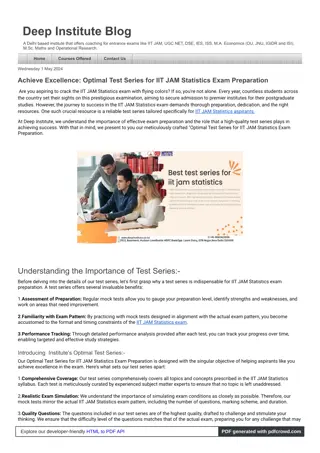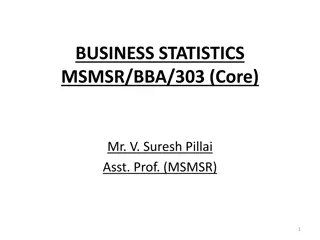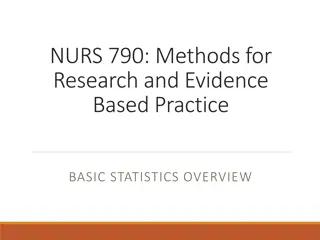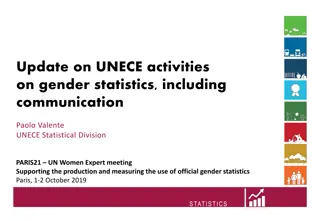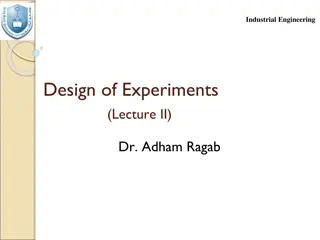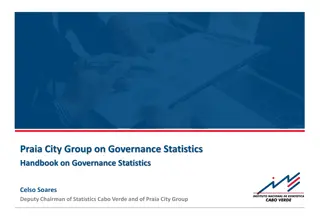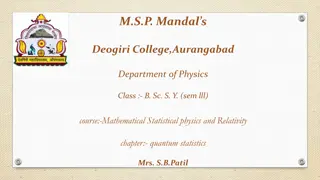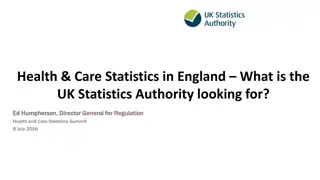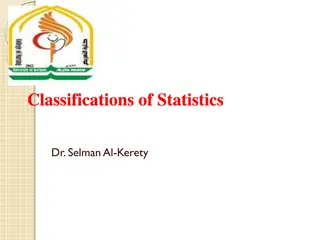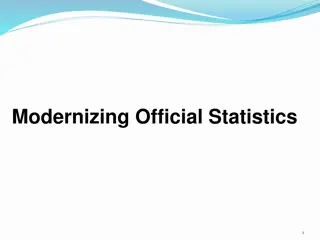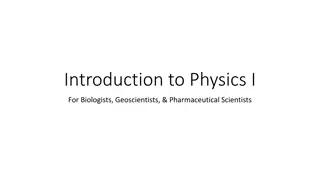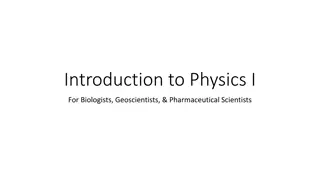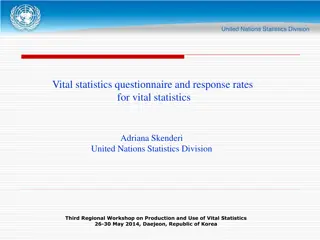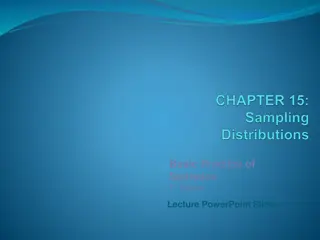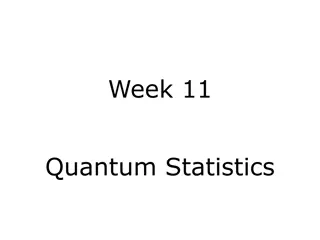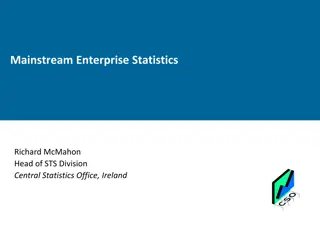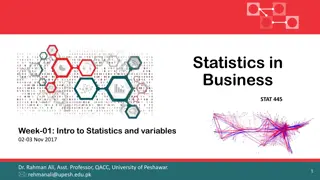Statistics for Biologists Lecture Series Overview
This content delves into the fundamentals of statistics for biologists, covering topics such as hypothesis generation, errors in hypothesis testing, the significance of p-values, and test statistics types in a comprehensive manner. It explores concepts like null and alternative hypotheses, Type I and Type II errors, and the calculation of p-values, providing insights into statistical analysis methods relevant to biologists' research work.
Download Presentation

Please find below an Image/Link to download the presentation.
The content on the website is provided AS IS for your information and personal use only. It may not be sold, licensed, or shared on other websites without obtaining consent from the author.If you encounter any issues during the download, it is possible that the publisher has removed the file from their server.
You are allowed to download the files provided on this website for personal or commercial use, subject to the condition that they are used lawfully. All files are the property of their respective owners.
The content on the website is provided AS IS for your information and personal use only. It may not be sold, licensed, or shared on other websites without obtaining consent from the author.
E N D
Presentation Transcript
Lecture Series: Statistics for Biologists Lecture 3, 12-09-2016 Gopal Karemore, PhD Novo Nordisk Center for Protein Research (Protein Imaging Platform) & Danish Stem Cell Center Organizer: Claudia Lukas Anne Grapin-Botton Jutta Maria Bulkescher 1
Generating Hypothesis (lecture 2 ) Null Hypothesis (H0) Experimental = Control or Experimental Control = 0 Science is all about Falsification and not confirmation e.g. Alternative Hypothesis (HA) Coffee Experimental != Control or Experimental Control != 0 smoking Pancreatic cancer 3
Errors in hypothesis testing (Lecture 2 ) Observed conclusion Accept H0 No observed difference Reject H0 Observed difference H0 (true) No difference Correct decision (True Negative) Type I error Unknown truth (False Positive) H0 (false) Difference Type II error Correct decision (True Positive) (False Negative) Probability of making Type I error Level of Significance Probability of making Type II error (1-B) is the power of the test 4
p-value The p-value is defined as the probability of obtaining a result equal to or "more extreme" than what was actually observed, when the null hypothesis is true. (https://en.wikipedia.org/wiki/P-value) Sir Ronald A Fisher introduced P values in the 1920s The greatest biologist since Darwin The p-value, or calculated probability, is the probability of finding the observed, or more extreme, results when the null hypothesis (H0) of a study question is true the definition of 'extreme' depends on how the hypothesis is being tested. www.statsdirect.co.uk test statistics (or one more extreme) just by chance alone when Null hypothesis is true. Prof. Marie Diener-West http://www.jhsph.edu/ The p-value is the probability of obtaining the value of the 5
Test Statistics (sample statistics hypothesized value) Test statistics = Standard error of the sample statistics e.g. In case of Difference between Independent sample means (two sample) Sample statistics = observed difference between sample means Standard error of the sample statistics = standard error of difference between the means hypothesized value = 0 i.e. No difference between means
Test Statistics Types Parametric Tests or Standard Test of hypotheses Depends on certain assumption of parent population from which we draw samples. e.g. normal population, large sample size etc. Z-test, t-test, x2-test (Chi-square test), F-test < Test Statistics Non-parametric tests or distribution-free test of hypotheses Does not depend on any assumption about parameters of the parent population Wilcoxon mann whitney test, Kruskal Wallis test < Test Statistics
Why cant we always use non- parametric tests? NPT need more samples (n) to achieve same Type 1 and Type 2 errors as that of PT You compromise with the Power of your test It is not intuitive as parametric In some cases the population may not be normally distributed, yet tests will be applicable on account of the fact that we mostly deal with samples and sampling distributions closely approach normal distribution. Recent Techniques: Bootstrapping, Robust parametric tests
*Which test statistics to be used Question 1 : Purpose of your Hypothesis Question 2 : Nature of your sample Association between Categorical data Difference of Means Difference of Variance Difference of Medians Two groups More than Two groups One or Two groups More than Two groups F-test Chi-square test Fisher's exact test Small Sample Size Large Sample Size (Lecture 4) Z-test t-test ANOVA Wilcoxon-Mann-Whitney test Kruskal Wallis test Paired unpaired
Difference of Means (two sample case, u1, u2) Case 1 1 1 Case 2 2 2 Case 3 3 3 Mean 1 (u1) Mean 2 (u2) 1< 2 < 3 Analysis of Variance ( 2)
Hypothesis testing of Means Hypothesis Question (plain english): Patients on Drug (readout): [20 12 15 18 24]; u1=17.8, 1= 4.6 Patients on Placebo (readout): [23 19 18 20 26]; u2=21.2, 2= 3.3 Hypothesis Question: H0: u1 u2 = 0 Ha1: u1 u2 !=0 (two tail) Ha2: u1 u2 > 0 (one tail) Conditions: t-test: Sample size Small Variance of population unknown Z-test: Population normal or infinite Population normal or infinite Sample size large or small Variance of population known
Student's t-test William Sealy Gosset One-sample t-test Dependent t-test for paired samples Independent two-sample t-test Equal sample sizes, equal variance Equal or unequal sample sizes, equal variance H0 Critical region Unequal Variance Welch's t-test t > tc : reject H0 t < tc : accept H0 tc tc
Degrees of Freedom (d.f.) A = 20 B = 25 C= 30 Average=25 n = 3 A Average = -5 B - Average = 0 C Average = ? Average=25 n = 3 This has to be +5 if the sum needs to be zero (A Average) + (B Average) + (C Average) = 0 This can take any value This can take any value This can not take any value This is fixed degrees of freedom = n-1 = 3-1 = 2 Conservative
Examples (one sample t-test ) A one sample t-test allows us to test whether a sample mean (of a normally distributed variable) significantly differs from a hypothesized value. Patients on Drug (readout): [20 12 15 18 24]; We think average drug readout H0 = 0; let s test our hypothesis [H,P,CI,STATS] = ttest([20 12 15 18 24],H0) H = Reject null hypothesis at 5% significance level STATS = CI = P = 1 tstat: 8.6444 df: 4 sd: 4.6043 12.0829 23.5171 9.8496e-04 [H,P,CI,STATS] = ttest([20 12 15 18 24],17.8) STATS = CI = H = Fail to reject null hypothesis at 5% significance level P = 0 tstat: 0 df: 4 sd: 4.6043 12.0829 23.5171 1
Critical region P-value 2.77 8.6444 - 2.77 Probability of getting 8.644 or more extream is nothing but the p-value of t-test The p-value is the probability of obtaining the value of the test statistics that you obtained (or one more extreme) just by chance alone when Null hypothesis is true.
Examples (two sample t-test ) ttest2(X,Y) Performs a t-test of the hypothesis that two independent samples, in the vectors X and Y, come from distributions with equal means Patients on Drug (readout): [20 12 15 18 24]; u1=17.8, 1= 4.6 Patients on Placebo (readout): [23 19 18 20 26]; u2=21.2, 2= 3.3 H0= u1-u2 = 0 = Null Hypothesis [H,P,CI,STATS] = ttest2([20 12 15 18 24],[23 19 18 20 26]) H = Fail to Reject null hypothesis at 5% significance level STATS = CI = P = 0 tstat: -1.3461 df: 8 sd: 3.9937 -9.2247 2.4247 0.2152
Effect of Alpha on two sample t-test [H,P,CI,STATS] = ttest2([20 12 15 18 24],[23 19 18 20 26], alpha ,0.05) Fail to Reject null hypothesis at 5% significance level (95% confidence) STATS = CI = P = H = tstat: -1.3461 df: 8 sd: 3.9937 -9.2247 2.4247 0.2152 0 [H,P,CI,STATS] = ttest2([20 12 15 18 24],[23 19 18 20 26], alpha ,0.01) Fail to Reject null hypothesis at 1% significance level (99% confidence) STATS = CI = P = H = tstat: -1.3461 df: 8 sd: 3.9937 -11.8753 5.0753 0.2152 0
Effect of tail (one/two) on t-test Group A Group B [H,P,CI,STATS] = ttest2([20 12 15 18 24],[120 112 115 118 124],'tail',both') Reject null hypothesis at 5% significance level (95% confidence) STATS = CI = P = H = tstat: -34.3401 df: 8 sd: 4.6043 -106.7152 -93.2848 5.6524e-10 1 Thereis a difference betweenGroup A and Group B [H,P,CI,STATS] = ttest2([20 12 15 18 24],[120 112 115 118 124],'tail','right') Fail to Reject null hypothesis at 5 % significance level (95 % confidence) STATS = CI = P = H = tstat: -34.3401 df: 8 sd: 4.6043 -105.4151 Inf 1.000 0 [H,P,CI,STATS] = ttest2([20 12 15 18 24],[120 112 115 118 124],'tail','left') Reject null hypothesis at 5 % significance level (95 % confidence) STATS = CI = P = H = tstat: -34.3401 df: 8 sd: 4.6043 -Inf -94.5849 2.8262e-10 1
Paired t-test Sample Baseline Follow-up 1 20 120 2 12 132 3 15 117 4 18 111 5 24 20 ttest(X,Y) performs a paired t-test of the hypothesis that two matched samples, in the vectors X and Y, come from distributions with equal means. [H,P,CI,STATS]=ttest([20 12 15 18 24],[120 132 117 111 20]) Reject null hypothesis at 5% significance level (95% confidence) STATS = CI = P = H = tstat: -3.7354 df: 4 sd: 49.2057 -143.2969 -21.1031 0.0202 1
Non-parametric test (difference in medians) Mann-Whitney U test/ Wilcoxon rank sum test [P,H,STATS]=ranksum([20 12 15 18 24],[120 132 117 111 20]) Reject null hypothesis at 5% significance level (95% confidence) STATS = CI = P = H = ranksum: 16.5000 NA NA 0.0238 1 Power Increment [H,P,CI,STATS] = ttest2([20 12 15 18 24],[120 132 117 111 20]) Reject null hypothesis at 5% significance level (95% confidence) STATS = CI = P = H = tstat: -4.0305 df: 8 sd: 32.2467 -129.2300 -35.1700 0.0038 1 Thereis a difference betweenGroup A and Group B
More than two groups: ANOVA (Linear Models..Lecture 5) Case 1: One- way Analysis of Variance Purpose: To find out whether data from several groups have a common mean To determine whether the groups are actually different in the measured characteristics H0 = all group means are equals or Matlab/SPSS [p,tbl,stats]=anova1(MyData) Example Box plots Exp3 Exp4 Exp1 Exp2 Exp5 47 37 34 30 42 38 30 32 30 47 44 35 30 27 42 50 40 36 30 38 56 37 35 35 33 46 39 41 41 43 Experiements are not same Chance of otherwise is (1 in 10,000) MyData
Multiple Comparison or Post hoc analysis (SPSS) Case 1: One- way Analysis of Variance Purpose: To find out pairs of means are significantly different Types: honestly significant differences, least significant difference, tukey-kramer (default), dunn-sidak, bonferroni, scheffe. Matlab/SPSS p-value tukey-kramer Experiment pair [c,m]=multcompare(stats) [p,tbl,stats]=anova1(MyData) 0.005 0.001 0.000 0.211 0.971 0.554 0.480 0.887 0.190 0.029 1 1 1 1 2 2 2 3 3 4 2 3 4 5 3 4 5 4 5 5 Experiements are not same Chance of otherwise is (1 in 10,000)
More than two groups: ANOVA (Linear Models) Case 2: Two- way Analysis of Variance (Factorial Analysis of Variance) Purpose: To find out whether data from several groups have a common mean with TWO categories of defining characteristics. H0 = all group means are equals Example: Suppose you have 5 groups in your experiment and you have possibility of doing these experiment in 2 different manner (e.g. two replicates or two labs or two concentrations). It will be called 2 x 5 factorial analysis Interest: If you would like to know how readout varies from experiments to experiment as well as lab location to lab location independently (for example). Main effects/additive effects Difference in the group of one independant variable vary according to the level of second independant variable Interaction/ Moderator effects
Understanding Main effects and Interactions Placebo DrugX dx1 Treatment Effect (Mortality Rate) Interaction (difference of difference) Is dx2>dx1? dx2 Follow-up (T1) Baseline (T0) Years/Hours
Example : Two-way ANOVA drug_study Use F-statistics to do hypotheses to find out if the treatment effect is same across time points, drugs and timepoint-drugs pair [p,tbl,stats]=anova2(drug_study,3) Treatement effect varies from one drug to another Treatement effect varies from baseline to followup No interaction between time points and drugs on treatment effect
Nonparametric ANOVA One way ANOVA :- Kruskal-Walis Test Example Box plots [p]=kruskalwalis(MyData) Exp3 Exp4 Exp1 Exp2 Exp5 p = 0.002 47 37 34 30 42 38 30 32 30 47 44 35 30 27 42 50 40 36 30 38 56 37 35 35 33 46 39 41 41 43 MyData
Nonparametric ANOVA Two way ANOVA :- Friedman s Test [p,tbl,stats]=friedman(drug_study,3) Friedman s test can t compute Interactions [p,tbl,stats]=anova2(drug_study,3)
Thank You! Normalization methods (HCS) Chi-square test



